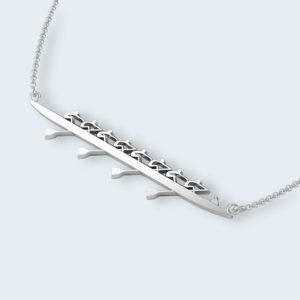In Part 1 of this topic I discussed the role of posture in the rowing stroke and how good posture can be used to avoid or to manage lower back injury. This was in response to a question by a Rowperfect reader:
“I have a couple of athletes that have low back injuries or are on the verge of injury due to lack of glute and hamstring strength. I think that this issue is common with rowers. I was hoping you would consider writing an article addressing this, with similar videos of exercises for thp to do like the core exercises posted in the most recent newsletter.”
Posture sets the basis for a supported back and power transferring properly through the torso, but relies on strength and flexibility to create a fast and efficient stroke which can be sustained for a full outing.
Strength vs Flexibility
When I think about the role of the lower back in the rowing stroke it serves to provide length at the catch and the finish, and allow the leg power to be sent directly to the handle.
Length at the catch, as seen in the videos in Part 1, should be achieved by hinging forward from the hip so the back stays fairly straight, not reaching with the shoulders and curving the back. At the finish the lower back keeps the torso supported by staying engaged and not slumping. Through the leg drive the back should stay in the catch position until the legs are almost fully down to allow the hip angle to open and accelerate the shoulders back towards the bows. These positions can only be achieved with flexibility and be held under power by strength. The opening of the hips is a dynamic movpent which combines strength and power with the right sequence of muscle movpents.
Working on both strength and flexibility, especially in dynamic movpents, will allow rowers to row fast with good posture and minimise their risk of lower back injury.
Exercises
These exercises should be seen as ‘Dynamic Strength & Flexibility’ exercises, rather than just weight-lifting exercises. They do not need to be done with much weight on the bar, the focus should be on making the movpents with the correct posture (keeping the back straight and thinking about hinging from the hips), the full range of movpent (stretching the muscles to improve range), speed of movpent (some are purposefully slow and others need to be rapid) and dynamic sequencing (using muscles in the right order to accelerate the movpent).
For juniors these exercises are ideal. The athletes are using weight-lifting equipment (use lighter bars for younger athletes) but to do flexibility and postural exercises. They are usually excited about starting a new type of exercise (weight lifting is fun!) but from a coaching point of view you are getting thp to do the flexibility work which they usually find boring.
For athletes who already have lower back weakness, start slow and light. Test your range and speed gently and only do a few exercises at first. See how your previous injury is affected by each exercise before continuing or adjusting your programme.
Good Mornings
This exercise includes a hamstring stretch, work on posture through hinging from the hips, and some power work to develop hip and lower back strength and speed of opening the hip angle.
The slow version should be done first to work on posture and range, before building in the power/speed version and adding a small amount of weight as technique and speed improves.
Straight-Leg Dead Lift
Similar to ‘Good Mornings’, this exercise also works on the flexibility of hamstrings and posture of lower back.
The stretch should be felt on the hamstrings and not the mid or upper back. Keep the bar close to the shins and keep shoulders in a strong, wide position. You should be reaching from your hips and not over-extending the shoulder joint. Hold the stretched position for a second or two. Use the glutes, hips and hamstrings to bring yourself upright. Rppber that this is a flexibility and posture exercise so don’t add much weight to the bar.
Hip Explosions (with High Pull) & Cleans
These exercises are all progressions towards the ‘Clean’ but they rpove the difficult timing of the leg drive and the hip action in the full Clean lift, focussing on the hip drive instead.
The Hip Explosion is used to develop hip strength, power and speed. The starting position is crucial; shoulders should be slightly forward of hips to give an angle to open, knees above the middle of the feet. The hips thrust forwards and thighs make contact with the bar. Don’t think about lifting the bar, the speed of the ‘triple extension’ (ankles, knees and hips fully extended) should be enough to bring the bar upwards quickly. Lock the arms to resist the bar moving up.
The High Pull is the same as the Hip Explosion but you release the elbows and allow the bar to float upwards. Shrug the shoulders and keep the elbows up but, again, don’t think about actively lifting the bar.
The Clean from Thigh is a further progression which adds a ‘catch’ before the High Pull is complete. The hip power drives the bar upwards and the athlete ‘ducks’ underneath immediately after they have fully extended their hips to catch the bar.
In all of these exercises the speed of the hips opening the angle between thigh and torso should be as quick as possible.
Hip Dips
Hip Dips are about strength and range, and discovering which muscles work to open and close the hip angle.
Keep the lower back strong and continue to focus on hinging from the hip. Weight can be added to the bar to develop more strength.
Stretches
Improved flexibility will increase stroke length and allow rowers to row with good posture for longer. The key muscles to work on for good posture are hamstrings, hips and glutes.
See my previous articles on Static Core and Dynamic Core exercises to improve posture, strength and stability.
Let us know if you have any feedback using the comments section.
Related articles
- Managing and Avoiding Lower Back Injury – Part 1: Posture (rowperfect.co.uk)








This Post Has 2 Comments
Hi Ben, thank you for your well researched articles and presentation. I have many questions re back injuries and anatomical geometry [was Kinesiology way back in the ’60’s] .
— I would like to see the erg videos done on a Rowperfect, as this machine if far more gentle on the whole spine and body. Especially for the rowers first two years of development.
— You’re not alone as soooo many coaches and rowing literature talk about DRIVE . For a newly conscripted rowers, what does this word actually mean? Or translate into?
I’ve found 10 in the dictionary
A clue — When a force curve, once displayed or subjectively saved and displayed as being an honorable “curve” we all goo and gaa but we don’t know what we’re looking at.
A two clue— The slide travel is close to twice the stroke length. therefore the data display means what? Yes, the actual position of the peak force developed in relation to the length of that particular stroke.
Cheers
Rob
Can we start to, Think For Ourselves and question a lot more or just believe the believer who believes in a belief?
Drive the leg so that you hover on the seat????? Should we thank an Olympian for pulling a gear failure!!!! The rule is repealed. Bless us All.
Greetings. To reduce lower back injury subject it to minimal, smooth work. To do this I suggest:
1. Allow the whole back to curve comfortably. Visit “Dr. Fiona Wilson back pain” in this regard.
2. Keep the handles as low as possible during the work My boat gates were set at 125mm average..
3. Layback at the catch, not after the legs are down. Do this by rotating just below the ribs as the catch is made. The normally coached pull while leaning forward is not what you would do in any other pulling effort.
4. Take the catch with the arms. Approach the catch with arms bent about 10″. They straighten fpr the catch, then rebound to about 8″ for the work. Your torso rebounds more smoothly, and the work begins. This is a smooth catch, with no jerking for the lower back.. It will also give a long reach. On the erg I catch the chain about 70mm from the block, and I,m only 5″10″.
5. Feather while the blades leave the water, not after. This will help drive the boat, and also allow the handles to be lower, which is needed with a lower gate heights..
6. Row always at 1:1 in:out, with a comfortable relaxed rhythm.
Have fun!